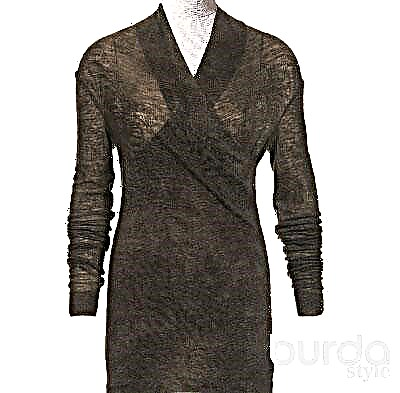The processing of the neckline of a dress or blouse with a trim trim is used more often than other methods. But it is not always possible to perform such processing perfectly or even well the first time.

Of course, a lot depends on the fabric and the chosen model, the presence or absence of an incision, a zipper and other details of the cut. But also from the experience and accuracy of this sewing operation.
On the Burda pattern sheets, the back and front cut-outs always go as separate parts. As a rule, the paper part of the facing (front and / or back) is given not in a spread, but with a fold.
After cutting the parts of the shelf and back and further during sewing, the linear dimensions of the cutout can slightly change, and the cutout itself can stretch, and then the stitching cut out from a paper pattern will not match the shape and length of the neckline. To avoid such a mishap, it is best to cut the grind in a U-turn on the details of the shelf and back.
Evening dress from velvet: we sew according to the Burda pattern
Step 1

Place the shelf part on the fabric.
Step 2

Determine the width of the grind with a ruler and place a mark at the shoulder cut of the part.
In this case, the turning width is 6 cm, taking into account allowances.
Step 3

By tailor's chalk, draw the contours of the grooves exactly along the neckline of the front and along the shoulder section to the mark.
Step 4

Draw the grind to the specified width (in this case, the grind width is 6 cm).
Step 5


Cut the front of the neckline exactly along the marked lines.
Important!
The allowances in the details of the grinding are already taken into account, since we cut it out according to the details of the shelf.
Step 6

Check yourself: put a hem on the neckline, they should match.
Step 7

In the same way, cut the back of the neckline.
Step 8

Duplicate trim parts.
Step 9

Grind the neckline of the shelf and back.
Cut allowances on a corner.
Iron the seams.
How to fit a sleeve
Step 10

Place the grind on the neckline with the front side facing the front side.
Often chop or sweep, precisely combining sections of parts.
Step 11

Grind along the marked seam line.
Step 12


If necessary, ground the grind (its width should be the same throughout the part).
In this case, the width of the tuck after basing became 4 cm
Step 13

Process the external cut of the overlock on an overlock or in a zigzag stitch on a sewing machine. Iron.
It is also possible to turn over a section of a facing by an oblique inlay.
How to sew an oblique edging: 3 ways
Step 14

Cut the seam allowances to 0.5–0.7 mm (depending on the fabric).
If necessary, cut the allowances in the rounding points before reaching a stitch of approx. 2 mm.
In this case, the allowance on the edge is trimmed to 0.5 mm, the allowance on the neckline of the front and back is up to 0.7 mm.
Step 15

Iron the trim up.
Step 16
Only grind the grind to an allowance close to the seam of the grind (short to approx. 1 mm). This line will prevent turning off the grind.

In this case, the hem is sewn to the stock by hand with a bead stitch.
Step 17



Unscrew the inlet with a small adapter edge (1–2 mm) and iron it.
Step 18
Sew the stitching to the shoulder seams manually with a hidden stitch.
Tip:
✂ To avoid stretching the neckline of the shelf and back during the sewing process, you can lay a notch on the machine a little higher (1−2 mm) marking the seam line, and after attaching the stitching, remove the threads. This method is good in working with thin and transparent fabrics.
How to process the edge of a thin fabric
✂ Either reinforce the cut with a thin strip of non-woven kantenband if you work with regular fabric, or a form if you work with knitwear or oblique cuts.
Author of the master class and photo: Julia Dekanova



